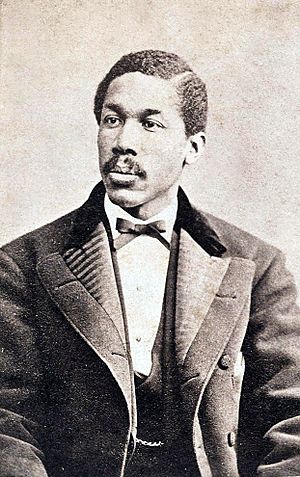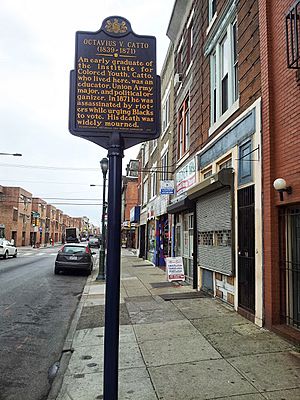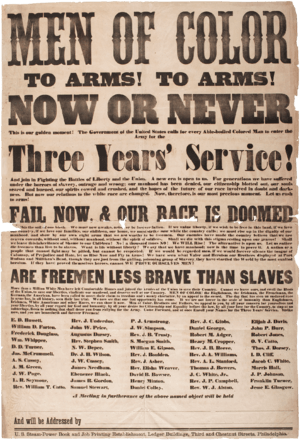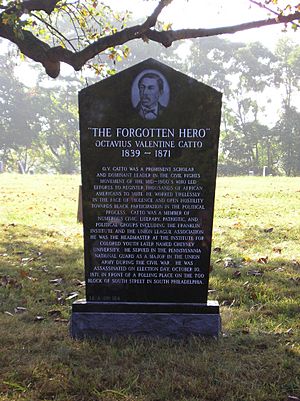Octavius Catto facts for kids
Quick facts for kids
Octavius Catto
|
|
|---|---|

Octavius Catto, Year unknown
|
|
| Born | February 22, 1839 |
| Died | October 10, 1871 (aged 32) Philadelphia, Pennsylvania, US
|
| Resting place | Eden Cemetery, Collingdale, Pennsylvania, US |
| Movement | Civil rights movement |
| Partner(s) | Caroline LeCount (fiancée) |
Octavius Valentine Catto (born February 22, 1839 – died October 10, 1871) was an important American educator, thinker, and civil rights activist. He worked hard to make life fairer for African Americans after the Civil War. Catto was also a talented cricket and baseball player in Philadelphia, Pennsylvania. Sadly, he was shot and killed on Election Day in Philadelphia while trying to vote.
Contents
Early Life and Education
Octavius Catto was born free in Charleston, South Carolina. His mother, Sarah Isabella Cain, came from a well-known mixed-race family that had been free for many years. His father, William T. Catto, was a formerly enslaved millwright who became a Presbyterian minister.
The Catto family moved north, first to Baltimore, then to Philadelphia. Pennsylvania was a free state, meaning slavery had been slowly ended there. Octavius's father helped start the Banneker Institute in Philadelphia, which was a group for African-American thinkers.
Octavius went to schools in Philadelphia that were specifically for African Americans. In 1853, he attended the Allentown Academy in Allentown, New Jersey, which was mostly white. A year later, he returned to Philadelphia and became a student at the Institute for Colored Youth (ICY). This school was run by the Society of Friends (Quakers) and taught subjects like Latin, Greek, geometry, and trigonometry.
Catto was a very good student. He gave presentations and joined discussions at a young men's instruction society at ICY. He graduated in 1858, praised for his "outstanding scholarly work." He then studied for another year in Washington, D.C., focusing on Greek and Latin.
Fighting for Equal Rights
In 1859, Catto returned to Philadelphia. He became a teacher of English and mathematics at the Institute for Colored Youth. He also joined the Banneker Institute as a recording secretary.
In 1864, Catto gave a speech at ICY's graduation. He talked about the importance of African-American teachers for African-American students. He also spoke about the American Civil War, saying that changes in the United States would help everyone, not just African Americans.
Catto was a strong supporter of equal rights. He worked with leaders like Frederick Douglass to help black men join the Union army during the Civil War. He helped raise eleven regiments of United States Colored Troops in the Philadelphia area. Catto himself was made a major in the army, but he did not fight in battles.
After the war, Catto continued his fight for equality. He became the Corresponding Secretary of the Pennsylvania Equal Rights League. He also worked hard to end segregation on Philadelphia's trolley car system. He worked with his fiancée, Caroline LeCount, and abolitionist William Still.
In 1865, Catto used civil disobedience to protest segregated streetcars. He once stayed on a streetcar even after the conductor took the horses off and left the car on the tracks! This act of protest got a lot of attention.
Catto also helped pass a Pennsylvania law that stopped segregation on public transportation. This was a big victory for civil rights.
His fight for equal rights reached a high point in 1869. Pennsylvania voted to approve the 15th Amendment. This amendment made it illegal to stop citizens from voting based on their race or color. This meant black men could now vote.
Sports Star
Besides his work in education and civil rights, Catto was also a talented athlete. He played cricket in school, which was a popular British sport. Later, he started playing baseball. After the Civil War, he helped make Philadelphia a major center for what would become Negro league baseball.
Catto and Jacob C. White Jr. ran the Pythian Base Ball Club of Philadelphia. The Pythians had a perfect season in 1867, winning all their games!
In 1869, the Pythians challenged white baseball teams to games. The Olympic Ball Club accepted. On September 4, 1869, the first baseball game between black and white teams took place. The Pythians lost, but it was an important step for racial equality in sports.
His Tragic Death
On Election Day, October 10, 1871, Octavius Catto was teaching in Philadelphia. The elections were very tense, and there was a lot of fighting between black and white voters. Black voters, who were mostly Republican, faced threats and violence from white voters, especially Irish immigrants who supported the Democratic Party. These Irish immigrants often competed with free black people for jobs and homes.
As Catto walked to vote, he was bothered by white people. He had bought a revolver for protection. At the corner of Ninth and South streets, a man named Frank Kelly shot Catto three times. Catto died from his injuries. Frank Kelly was never found guilty of the murder.
Catto's funeral was a military one and many people attended. His death, and the violence on Election Day, showed how difficult it was for African Americans to gain full rights. Catto's remains were later moved to Eden Cemetery in Collingdale, Pennsylvania.
Remembering Octavius Catto
For many years, people wanted to honor Octavius Catto. In 1878, a biographer wondered why Catto's grave was not being cared for. Later, in 1897, the New York Times reported that people wanted to build a monument to Catto.
In 1995, an annual ceremony began to remember Catto. In 2006, a fundraising campaign started to build a statue for him. A headstone was placed at his grave in Eden Cemetery in 2007.
In 2016, Philadelphia's Mayor Jim Kenney announced that a new sculpture would be built to honor Catto. This sculpture, called A Quest for Parity, includes a twelve-foot bronze statue of Catto. It was put up at Philadelphia City Hall in September 2017. This was the first public monument in Philadelphia to honor a specific African American.
See also




